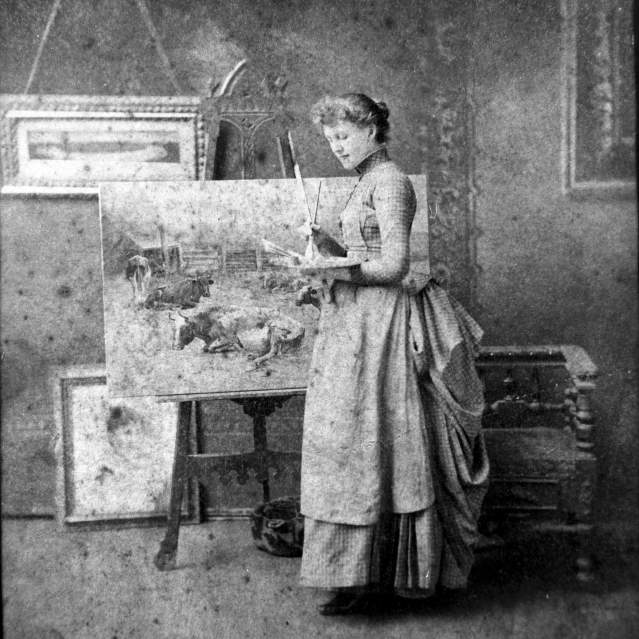What do Georgia O'Keeffe, Winslow Homer, Jackson Pollock, and Knoxville's own Adelia Armstrong Lutz have in common? Each of their homes has been inducted into the prestigious Historic Artists’ Homes and Studios (HAHS) network!
Westwood was accepted into the HAHS network in March 2022, a peer-to-peer coalition of sites that brings these museums together to conserve the legacy of creativity in the visual arts in the United States. Since its establishment by the National Trust for Historic Preservation in 1999, HAHS has developed into a successful community of practice, working with over 70-member sites that more than one million visitors in nearly every part of the United States. Explore more at artistshomes.org
Adelia Armstrong Lutz (1859 – 1931) was a Knoxville artist active in the late nineteenth and early twentieth centuries. She helped organize a number of art and cultural circles in Knoxville, most notably the Nicholson Art League, and was active in many social circles. During her lifetime, she exhibited throughout America, including at the 1893 Chicago World’s Fair and the 1897 Tennessee Centennial and International Exposition in Nashville. Her artwork is on permanent display at her former home, Historic Westwood.
Lutz was born Adelia Ann Armstrong at the home of her maternal grandparents in Jefferson County, Tennessee. She was the daughter of Robert and Louise Armstrong and granddaughter of Drury Payne Armstrong, an early Knoxville landowner whose house, Crescent Bend, still stands on Kingston Pike. She grew up in Bleak House, the antebellum mansion built by her father.
Lutz always had a natural talent for art. In her youth, she was known to doodle in her schoolbooks and paint flowers on the cover of her books. She often dramatized poems and her favorite novels by creating illustrations to go along with the readings. She also had a strong artistic kinship with her father, who was an amateur artist.
Lutz was known to paint a wide variety of subjects, but was especially fond of portraits, landscapes, and animals. She also had a gifted talent for painting flowers, especially hollyhocks. Besides her original works, she often painted copies of old masters that she studied in art school and in museums. Lutz not only painted for study, but she was frequently commissioned to paint portraits, routinely entered her paintings in competitions, and exhibited her work throughout the south.
Lutz honed her already exceptional talents by attending two prestigious art schools. In the spring of 1885 at the age of 26, Lutz studied at the Corcoran Gallery of Art in Washington D.C. and continued her studies in the winter of 1885 at the Pennsylvania Academy of the Fine Arts in Philadelphia. After her return from her studies, Lutz married John E. Lutz in February 1886 and then spent the next two years teaching art lessons in painting, drawing, and embroidery.
In 1890, John and Adelia built their grand home, Westwood, located on Kingston Pike. The home, designed by the noted Knoxville architect Baumann Brothers, was built in the Richardsonian Romanesque style which was so prominent at the time. The house was built with an art studio and gallery which is the crown jewel of the house. Lutz painted and displayed her paintings in the studio, inspiring her students and circle of family and friends. The studio consists of one long room resembling a cathedral, with a high ceiling and skylights. The walls are painted her preferred color of red and the fireplace is bordered with hand-painted tiles that reflect the portraits of her favorite authors. An undated newspaper article praised the design and ambience, describing the studio as, “A special room, with beautiful inlaid oak floors and a dado of low book cases has been set aside in Mrs. Lutz’ home for the display of the work of her brush. It is a room in which both the art lover and the book lover would sit and look and dream.”
Lutz spent her lifetime committed to the local art community, serving as the president of the Nicholson Art League in 1903-1904 and remaining an active member until her death in 1931. She also frequently wrote on the subject of art for the local newspapers and gave lectures on art and culture for local civic and literary clubs.
Historic Westwood is located at 3425 Kingston Pike and is open for tours on Tuesdays and Thursdays from 10 AM until 4 PM and Fridays from 10 AM until 2 PM. Free parking is available at the adjacent Laurel Church of Christ located at 3457 Kingston Pike. Explore more at knoxheritage.org


